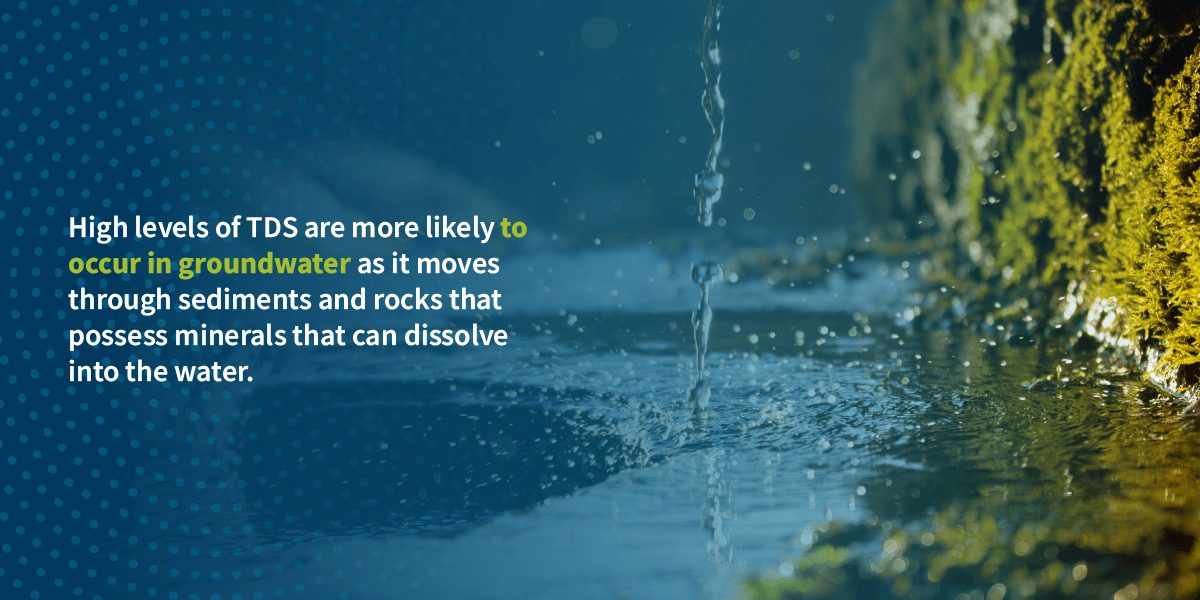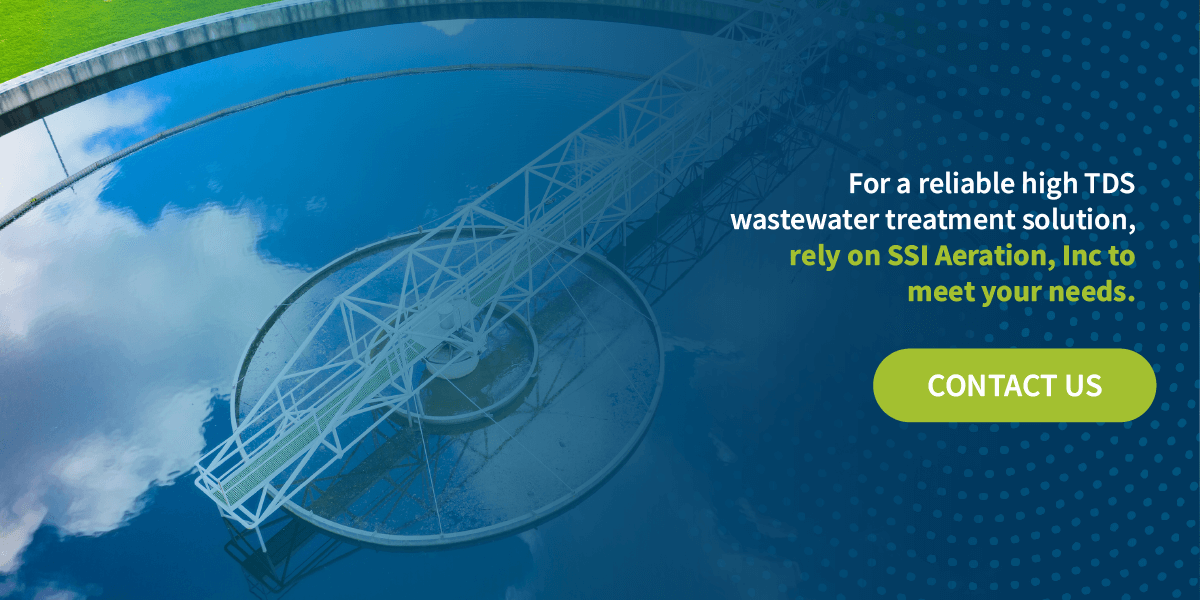How to Reduce Total Dissolved Solids From Wastewater
By: WebFx
Post Date: noviembre 4th 2024
Any facility that returns water to a natural source must reduce the presence of contaminants and dangerous substances in wastewater. Natural water sources and public systems are crucial for daily activities, and clean water is vital for supporting these activities. Water pollutants can quickly impact systems and threaten human health, making it critical to prioritize total dissolved solids (TDS) reduction strategies.

What Are Total Dissolved Solids and Their Effects?
Total dissolved solids refer to dissolved ions that can appear in non-pure water sources. Dissolved solids can be a range of elements, including minerals, dissolved metals, salts and organic matter.
Depending on the water source, location and other factors, some people and systems may experience more of one type of TDS than others. For example, water in lakes, streams or rivers that have contact with mineral-rich rocks may pick up more significant amounts of minerals like potassium, calcium and magnesium. Alternatively, water sources near locations where human activities, such as mining or industrial projects, take place may contain more metal impurities as a result of pollution.
Excess amounts of TDS can have a significant effect on day-to-day life. Knowing whether high TDS levels are present is crucial to ensuring access to clean water. Facilities discharging wastewater into a public system must understand the impact of TDS and how to reduce them when necessary. TDS can affect:
- General health: The biggest danger surrounding TDS is the impact on general health. Deposits can include trace elements like radium, arsenic and uranium. People may experience symptoms such as gastrointestinal irritation as a result of drinking water with high levels of these ions.
- Water taste and smell: One of the most noticeable effects of high TDS levels is the smell and taste they bring to water. Large amounts of some TDS, such as chlorides, can make water taste salty, and sulfates can produce a bitter taste.
- Plumbing: TDS can impact plumbing by causing appliances and plumbing systems to deteriorate faster. The excess minerals accelerate corrosive processes, impacting system function and delivering damage that can result in premature repairs or replacements. Furthermore, these deposits do not react well with soap and can leave scale deposits in water heaters and pipes.
- Cooking and cleaning: While small amounts of TDS may not be detrimental to general health, they can still impact cooking. TDS can alter the taste of food, often making it unpleasant. Additionally, these deposits can cause dishes and silverware to obtain water spots that are hard or impossible to remove.
What Are TDS Wastewater Standards?
Recommendations depict safe levels of TDS to be less than 500 mg/L for drinking. Low levels of TDS have no notable impact on human health, meaning some can exist in water without impacting daily life. In the United States, health-based substances have enforced Maximum Contaminant Levels. These regulations are crucial for businesses that discharge water into public systems or wells. Businesses must meet these requirements along with those of local governments and industry standards to ensure satisfactory operations.
The Environmental Protection Agency outlines discharge standards for various facilities and industries. TDS wastewater standards may vary depending on your business location, operations and other factors. For example, in Pennsylvania, standards state that operations with wastewater from field exploration, production, fracturing or drilling must adhere to several requirements. Some of these requirements include teams developing a reduction strategy for wastewater sources, discharge containing a monthly average of 500 mg/L or less, and discharge containing less than 250 mg/L of chlorides on a monthly average.
Methods of Reducing TDS in Water

High levels of TDS are more likely to occur in groundwater as it moves through sediments and rocks that possess minerals that can dissolve into the water. However, TDS can come from many sources, and businesses like wastewater treatment plants have unique responsibilities to avoid compromising operations or permit limits.
If high levels of TDS are present in wastewater, it’s critical to take steps to reduce them. Check out these strategies for removing TDS from wastewater:
1. Reverse Osmosis
Reverse osmosis is a common method for reducing the presence of TDS. This process involves removing contaminants and chemicals in wastewater by utilizing several filtration stages.
Installing a reverse osmosis system at a point-of-use location forces impurities to rebound off a semipermeable membrane, or a fine mesh filter. This membrane has very small pores, allowing water molecules to pass while preventing larger particles from reaching the end of the system. As the large particles rebound off this filter, they stick to the system chamber. Water constantly drains from this chamber, taking all the impurities with it and flushing them away.
2. Deionization
Deionizing is another successful method for reducing TDS. This process involves moving water through negative and positive electrodes. Positive ions break from the water to attach to the negative electrode, creating highly pure water.
It’s worth noting that deionization is excellent for treating ionic impurities but will not address nonionic particles. For example, this method can reduce the presence of nitrates, sulfates and phosphates but will not effectively address particles like ethoxylates. Often, facilities will combine deionization methods with other strategies, such as reverse osmosis systems, for comprehensive wastewater treatment.
3. Distillation
Another popular method for addressing high levels of TDS is distillation. Distillation helps remove organic and inorganic substances from water by boiling it until the water evaporates. The evaporated water moves along a cool surface until it reaches a separate container where it condenses.
Many contaminants and impurities have boiling points higher than water, meaning as the water evaporates, these other substances remain in their liquid or solid form in the boiling chamber. You can then remove the substances from the chamber during cleaning processes between uses. Additionally, distillation systems utilize a carbon filter, allowing the system to catch any impurities that are able to evaporate with the water from exiting the system.
Although this process is very effective at removing TDS, it can be time-consuming.
Choose Industrial and Commercial Wastewater Treatment Systems From SSI Aeration, Inc
SSI Aeration, Inc is a global leader in wastewater treatment plant equipment design and manufacturing. Utilizing innovative technology and years of industry experience, the team at SSI Aeration, Inc creates various solutions, ranging from tube diffusers to PTFE membranes, for sewage and wastewater treatment plants. As a trusted source for treatment solutions, SSI Aerations has the systems facilities need to return clean water back to natural sources.
For a reliable high TDS wastewater treatment solution, rely on SSI Aeration, Inc to meet your needs. Reach out to discover the possibilities of wastewater treatment.


